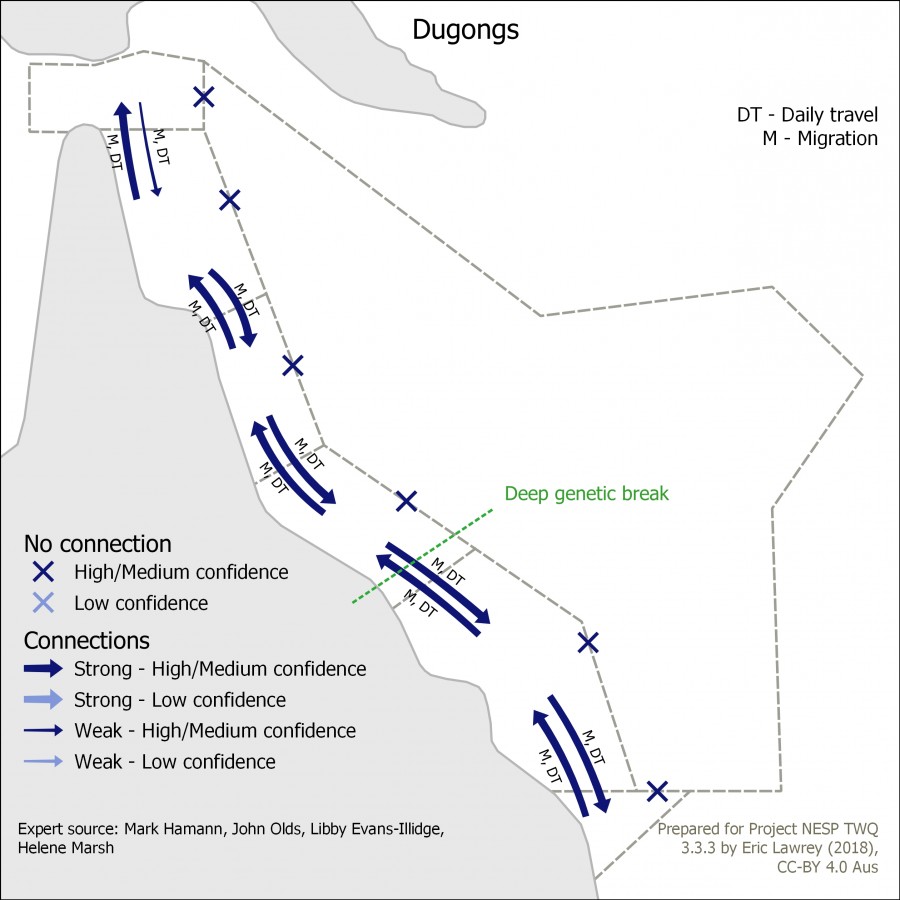Dugong - Connections between the GBR and neighbouring regions

Introduction to dugongs and why they are important
Dugongs play an important role in coastal ecosystems via the structuring effect they have on seagrass communities (Aragones and Marsh 2000, Aragones et al. 2006). They also have special cultural significance for Indigenous people with hunting being an activity closely associated with Indigenous culture (Kwan 2005). Dugongs were also cited as one of the World Heritage values of the GBR during its listing. Dugongs (Dugong dugon) are listed as marine and migratory species under the Environmental Protection and Biodiversity Conservation Act (1999), and are listed as vulnerable under the Queensland Nature Conservation Act (1992).
Hervey Bay, the Great Barrier Reef and Torres Strait are all globally significant dugong habitats (Marsh et al. 2011) (Figure 1) with Torres Strait supporting the world’s largest dugong population. The latest estimate of the dugong population in Torres Strait was more than 100,000 animals, a likely underestimate (Hagihara et al. 2016). The Hervey Bay area is the most important dugong habitat on the east coast of Australia south of Cape York (Marsh et al. 2011). The 2016 population estimate for Hervey Bay was about 2,000 dugongs (Sobtzick et al. 2017) (Figure 1). Although the Coral Sea likely supported refugia for dugongs during past glacial maxima (Blair et al. 2014), there is no evidence that this area supports significant dugong habitat today.
Dugong distribution along the Queensland coastline (1986 - 2005) and the Torres Strait (1987 - 2011).
Figure 2. Map showing the distribution of dugong based on aerial observations. Source: AIMS eAtlas and Grech and Marsh (2011).Key concepts that relate to connectivity
Changes in the spatial distribution of dugongs are largely driven by migration in response to changes in the extent and biomass of the seagrasses on which dugong depend for food (Marsh et al. 2011). These changes are associated with sub-regional climate drivers (Meager and Limpus 2014, Fuentes et al. 2016), particularly the sustained periods of elevated freshwater discharge and low air temperatures associated with La Niña episodes. In response to these changes in food supply, dugongs move between seagrass habitats along the Queensland coast and possibly offshore where there are deep water and reef top seagrass beds (Coles et al. 2009, McKenzie et al. 2016).
Dugong movements between Hervey Bay and the GBR as far north as Clairview (north of Shoalwater Bay) have been confirmed by satellite tracking (Sheppard et al. 2006) and to Shoalwater Bay by pedigree analysis (Cope et al. 2015). It is likely that dugongs also move between Hervey Bay and the southern GBR more often than documented. Aerial surveys also indicate that dugongs move between the southern GBR and Hervey Bay as a result of seagrass dieback in the north prior to any habitat recovery (Sobtzick et al. 2012, 2017) (see Figure 2).
References
Aragones, L., Marsh, H. (2000) Impact of dugong grazing and turtle cropping on tropical seagrass communities. Pacific Conservation Biology 5, 277-288.
Aragones, L. V., Lawler, I. R., Foley, W. J., Marsh, H. (2006) Dugong grazing and turtle cropping: grazing optimization in tropical seagrass systems? Oecologia 149, 635-647.
Blair, D., McMahon, A., McDonald, B., Tikel, D., Waycott, M., Marsh, H. (2014) Pleistocene sea level fluctuations and the phylogeography of the dugong in Australian waters. Marine Mammal Science, 30 (1), 104-121.
Coles, R., McKenzie, L., De’ath, G., Roelofs, A., Long, W.L. (2009) Spatial distribution of deepwater seagrass in the inter-reef lagoon of the Great Barrier Reef World Heritage Area. Marine Ecology Progress Series, 392, 57-68.
Cope R.C., Pollett, P.K., Lanyon, J.M., Seddon, J.M. (2015) Indirect detection of genetic dispersal (movement and breeding events) through pedigree analysis of dugong populations in southern Queensland, Australia. Biological Conservation, 181, 91-101. doi:10.1016/j.biocon.2014.11.011.





